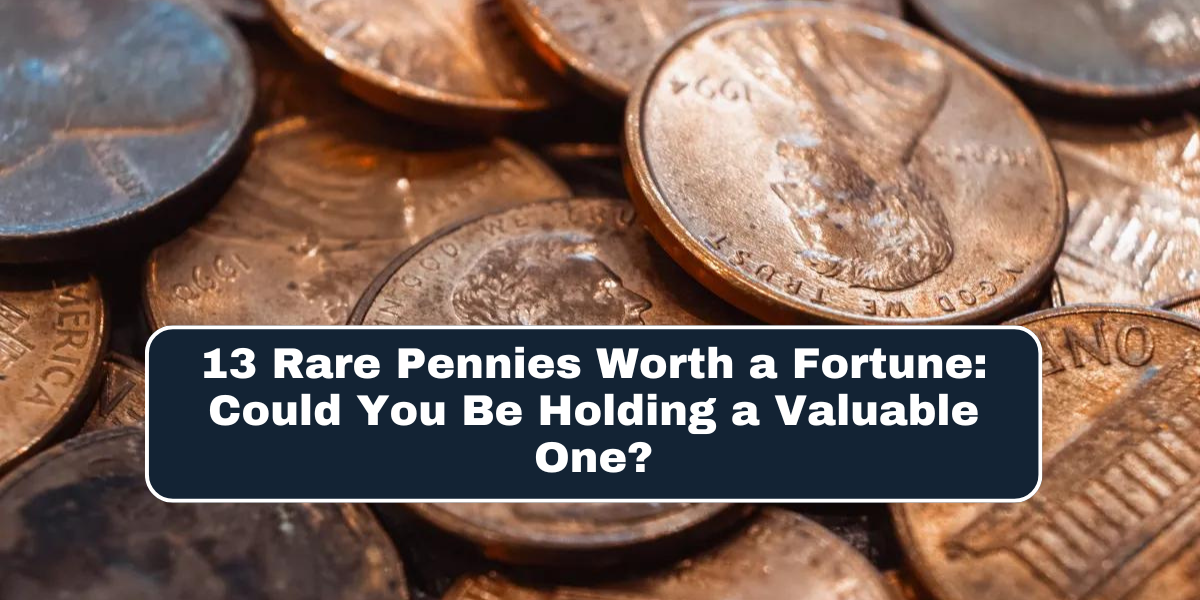13 Rare Pennies Worth a Fortune : Pennies, often regarded as insignificant pocket change, can surprisingly hold immense value. While their face value is just one cent, certain rare pennies have garnered significant attention and command astonishing prices at auctions. These exceptional coins are not just simple currency but are prized for their unique characteristics, historical significance, or production errors. The fascination with these pennies lies in their rarity and the stories they tell about past minting practices and historical events.
In this blog, we’ll explore thirteen of the most expensive pennies ever sold, each one representing a remarkable blend of rarity, error, or historical importance. From wartime production errors to early American prototypes, these rare pennies have achieved notable auction prices, reflecting their exceptional value and the high demand among collectors.
Table of Contents
Rare Pennies Worth a Fortune
Here are 13 Rare Pennies Worth a Fortune:
I. The 1943-D Lincoln Bronze Cent
The 1943-D Lincoln Bronze Cent is a celebrated error coin from World War II. During this period, the U.S. Mint switched to zinc-coated steel for pennies to conserve copper for military use. However, a few bronze planchets from the previous year were mistakenly used in 1943. This mistake resulted in a rare and valuable coin. Only one known example of the 1943-D Lincoln Bronze Cent exists, making it extremely sought after by collectors.
The coin’s rarity and historical significance contribute to its astronomical value. In 2010, it sold for a record-breaking $1.7 million at auction, highlighting the extreme demand for this rare error coin among numismatists.
Historical Context
During World War II, the U.S. Mint transitioned to using zinc-coated steel for pennies to conserve copper for the war effort. However, a few bronze planchets were accidentally used in 1943, creating an exceptionally rare error coin.
Auction Price
In 2010, a 1943-D Lincoln Bronze Cent was sold for a staggering $1.7 million, setting a record for the most expensive penny ever sold.
II. The 1943-S Lincoln Bronze Cent
The 1943-S Lincoln Bronze Cent is another rare error coin from the same period as the 1943-D. Minted in San Francisco, this penny also resulted from the accidental use of bronze planchets during a time when the U.S. Mint had switched to steel for penny production. Like its Denver counterpart, it is exceedingly rare due to its unique production error.
In 2012, a 1943-S Lincoln Bronze Cent fetched $1 million at auction. This high price reflects the rarity and collector interest in these wartime error coins, which are among the most valuable in numismatic history.
Historical Context
Minted in San Francisco, this coin is among the few 1943 bronze pennies known to exist due to the same production error that affected the 1943-D.
Auction Price
In 2012, a 1943-S Lincoln Bronze Cent was auctioned for $1 million, underscoring the high value of these error coins.
III. The 1792 Birch Cent
The 1792 Birch Cent is a historical treasure and one of the earliest prototypes of the U.S. cent. Designed by Robert Birch, this coin represents a significant milestone in American coinage. Only a few of these prototype coins were produced, making them incredibly rare and valuable.
In 2015, a 1792 Birch Cent sold for $2.58 million, underscoring its importance and the high demand among collectors. Its historical significance and rarity make it a coveted item for serious numismatists and collectors alike.
Historical Context
Only a few of these coins were ever minted, making them extremely rare and highly valuable to collectors.
Auction Price
In 2015, a 1792 Birch Cent sold for an impressive $2.58 million, highlighting its importance in American numismatic history.
IV. The 1944-S Steel Lincoln Penny
The 1944-S Steel Lincoln Penny is a notable error coin from a year when the U.S. Mint returned to using copper for pennies. Due to a production mix-up, some steel planchets from the previous year were used in 1944, creating this rare steel penny. Its production error makes it a highly sought-after item.
In 2008, a 1944-S Steel Lincoln Penny was sold for $373,750 at auction. This significant price reflects its rarity and the appeal of error coins in the numismatic community.
Historical Context
In 1944, the U.S. Mint resumed using copper for pennies, but some steel planchets from the previous year were mistakenly used, leading to this rare steel penny.
Auction Price
In 2008, one of these pennies was sold for $373,750, demonstrating its significant value among collectors.
V. The 1909 VDB Matte Proof Lincoln Penny
The 1909 VDB Matte Proof Lincoln Penny marks the debut year of the Lincoln Cent and is distinguished by its designer’s initials, V.D.B. Only a few dozen of these coins were minted with a matte proof finish, making them exceptionally rare and valuable.
In 2014, a 1909 VDB Matte Proof Lincoln Penny sold for $258,500. The combination of its early production year and limited mintage contribute to its high value among collectors.
Historical Context
Only a few dozen of these pennies were minted in matte proof condition, making them highly sought after.
Auction Price
In 2014, a 1909 VDB Matte Proof Lincoln Penny sold for $258,500, reflecting its rarity and historical value.
VI. The 1958 Doubled Die Obverse Lincoln Penny
The 1958 Doubled Die Obverse Lincoln Penny is known for its distinctive doubling error on the obverse side of the coin. This error occurred when the die used to strike the coins was misaligned, causing the date and lettering to appear doubled.
Only three known examples of this penny exist, which adds to its rarity. In 2018, one sold for $336,000, highlighting the premium placed on error coins and their desirability in the collector’s market.
Historical Context
This error occurred when the die used to strike the coins was misaligned, causing a doubling effect on the date and lettering.
Auction Price
In 2018, one of these pennies sold for $336,000, a testament to the allure of error coins.
VII. The 1943 Lincoln Cent Struck on Bronze Planchet
The 1943 Lincoln Cent Struck on Bronze Planchet is another rare error from the wartime period. Like the 1943-D and 1943-S, this penny was mistakenly struck on a bronze planchet instead of the steel planchets intended for that year. The error results in a highly sought-after coin.
In 2013, this penny sold for $840,000, illustrating its significant value. The rarity and historical context of these 1943 bronze cents make them especially prized among collectors.
Historical Context
Like other 1943 bronze pennies, this coin was mistakenly struck on a bronze planchet, making it a highly valuable error coin.
Auction Price
In 2013, a 1943 Lincoln Cent struck on a bronze planchet was sold for $840,000.
VIII. The 1793 Chain Cent
The 1793 Chain Cent is a historic coin, being the first penny issued by the U.S. Mint. Its distinctive chain design on the reverse was short-lived due to its controversial nature, leading to a quick redesign. This rarity boosts its worth.
In 2011, a 1793 Chain Cent was sold for $2.35 million. Its historical importance and the rarity of surviving examples make it a top collectible in American numismatics.
Historical Context
The chain design was quickly replaced, making this coin a rare and important piece of American numismatic history.
Auction Price
In 2011, a 1793 Chain Cent sold for $2.35 million, reflecting its historical significance and rarity.
IX. The 1914-D Lincoln Penny
The 1914-D Lincoln Penny is a key date in the Lincoln Cent series, known for its low mintage. Minted in Denver, this penny is rare due to its limited production run, making it highly desirable to collectors.
In 2017, a 1914-D Lincoln Penny in excellent condition sold for $152,750. The low mintage and collectible nature of this coin contribute to its significant value in the numismatic market.
Historical Context
Minted in Denver, this penny is one of the lowest mintage issues, making it highly collectible.
Auction Price
In 2017, a 1914-D Lincoln Penny in excellent condition sold for $152,750.
X. The 1856 Flying Eagle Cent
The 1856 Flying Eagle Cent represents a transitional period in American coinage, moving from large cents to the smaller size used today. Only about 2,000 of these coins were minted, making them rare and historically significant.
In 2004, a 1856 Flying Eagle Cent sold for $172,500. Its limited mintage and role in the transition to the smaller cent design make it a valuable piece for collectors.
Historical Context
Only about 2,000 of these coins were minted, making them rare and valuable.
Auction Price
In 2004, a 1856 Flying Eagle Cent sold for $172,500, reflecting its historical importance.
XI. The 1922 No D Plain Lincoln Penny
The 1922 No D Plain Lincoln Penny is notable for its missing mint mark. Due to die wear at the Denver Mint, some 1922 pennies were struck without the “D” mint mark. This error makes the coin particularly rare.
In 2008, a 1922 No D Plain Lincoln Penny sold for $74,750. Its rarity due to the minting error contributes to its high value among collectors.
Historical Context
Some 1922 pennies were struck without the “D” mint mark due to die wear at the Denver Mint, making these coins rare.
Auction Price
In 2008, a 1922 No D Plain Lincoln Penny was auctioned for $74,750.
XII. The 1877 Indian Head Penny
The 1877 Indian Head Penny is known for its low mintage, with only 852,500 coins produced. This rarity makes it one of the most sought-after coins in its series. Finding this penny in excellent condition is challenging, further increasing its value.
In 2007, an 1877 Indian Head Penny in top condition sold for $149,500. Its limited production and the difficulty in finding well-preserved examples drive its significant value in the collector’s market.
Historical Context
With only 852,500 minted, this coin is difficult to find in excellent condition.
Auction Price
In 2007, an 1877 Indian Head Penny in top condition sold for $149,500.
XIII. The 1909-S VDB Lincoln Penny
The 1909-S VDB Lincoln Penny is famous among collectors for its rarity and the presence of the designer’s initials, V.D.B. Minted in San Francisco, it features a low mintage of 484,000, adding to its desirability.
In 2014, a 1909-S VDB Lincoln Penny was auctioned for $117,500. The combination of its limited mintage and the V.D.B. initials makes it a highly collectible coin.
Historical Context
Minted in San Francisco, this penny is rare due to its relatively low mintage of 484,000.
Auction Price
In 2014, a 1909-S VDB Lincoln Penny sold for $117,500.
Conclusion
The world of rare pennies is a fascinating realm where history, error, and exceptional condition converge to create valuable collectibles. From the wartime errors of 1943 to early American prototypes like the 1792 Birch Cent, these pennies have captivated collectors and achieved remarkable auction prices. Whether due to their unique production errors or historical significance, these pennies illustrate the rich history and enduring allure of numismatics.
FAQs
How can I value my penny?
To determine if your penny is valuable, look for rare features such as minting errors, unique historical contexts, or exceptional condition. Consulting a professional numismatist or using coin grading services can provide a more accurate assessment.
What factors affect the value of a rare penny?
The value of a rare penny is influenced by several factors, including rarity, historical significance, condition, and demand among collectors. Errors or unique features can significantly increase a penny’s value.
Where can I sell my rare pennies?
Rare pennies can be sold through reputable auction houses, coin dealers, or online marketplaces dedicated to numismatics. It’s advisable to get a professional appraisal before selling to ensure you receive a fair price.






